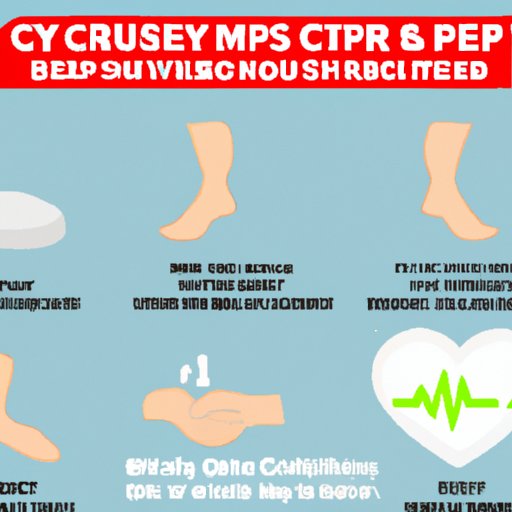
I. Introduction
Knowing how to perform CPR is a crucial life-saving skill that everyone should learn. It can mean the difference between life and death in the event of an emergency. In this article, we will provide a step-by-step guide to performing CPR, along with information on real-life examples, myths and misconceptions, a visual guide, personal experiences, and important considerations for different age groups.
II. List Step-by-Step CPR Instructions
If someone needs CPR and you are the first responder, follow these steps:
- Check to see if the person is unresponsive. Tap their shoulder and shout, “Are you okay?”
- Call for emergency medical services (EMS) by dialing 911, or ask someone else to do so if possible.
- Check for breathing by tilting their head back gently and looking for chest movement for 5-10 seconds.
- If they are not breathing or gasping for air, begin chest compressions. Place your hands in the center of the chest between the nipples and press down firmly and quickly (compressing at least 2 inches deep) at a rate of 100-120 compressions per minute.
- After 30 compressions, give 2 rescue breaths by tilting the head back again and pinching the nose shut while breathing into the person’s mouth for about 1 second per breath.
- Repeat steps 4 and 5 in cycles of 30 compressions and 2 breaths until the person responds or EMS arrives.
Examples of scenarios where CPR may be necessary include cardiac arrest, drowning, choking, or severe allergic reaction. It is important to remember that even if you don’t feel confident in performing CPR, any attempt at assistance can be helpful before professional help arrives.
III. Use Real-Life Examples and Case Studies
Real-life examples and case studies can provide valuable insight into the effectiveness of CPR and the importance of responding quickly. Nikki, a college student, saved her professor’s life by performing CPR after he collapsed in class. Another example involves a 14-year-old boy performing CPR on his mother who had a seizure and stopped breathing. These stories highlight the importance of knowing CPR and the impact it can have in a life-threatening event. On the other hand, there are tragic cases where CPR could have made a difference, but was not performed.
IV. Address Common Myths and Misconceptions
There are several common myths and misconceptions about CPR that can prevent people from performing it effectively. For example, some people believe that they need to give rescue breaths before starting chest compressions, but in reality, quick compressions are the most important step to start with. Other misconceptions include that chest compressions need to be paused to give rescue breaths or that the victim needs to have a pulse to start CPR. Providing accurate information can give readers the confidence they need to perform CPR effectively.
V. Include a Visual Guide
A visual guide is a powerful tool to show readers the correct technique for CPR. A diagram or short video demonstrating the key steps in the process can help readers understand exactly how to perform CPR. It is worth noting that CPR techniques have changed over the years, so it is recommended to use up-to-date guides and resources for the most accurate information.
VI. Share Personal Experiences
Personal experiences can connect readers to the subject matter on an emotional level. Stories from individuals who have performed CPR or required it themselves can inspire readers to learn this life-saving skill. For example, a mother sharing her story of performing CPR on her infant can demonstrate the importance of knowing how to perform CPR on different age groups.
VII. Explain CPR for Different Age Groups
Performing CPR on someone who is an infant, child, or adult requires different techniques to achieve the best results. CPR for infants involves giving compressions with two fingers and gentle breaths, while compressions for adults require more force and rescue breaths. Children usually require a combination of these techniques. It is important to learn how to perform CPR on each age group to provide the best chance of survival.
VIII. Highlight the Importance of Certification
Becoming certified in CPR is crucial for anyone who wants to be prepared to respond in an emergency. Proper certification ensures that you have been trained in the most up-to-date techniques and can give you the confidence to act quickly and effectively. Certification can typically be obtained through community organizations, hospitals, and training centers. It is important to note that CPR techniques can change, so it is recommended to take a refresher course every two years to stay up-to-date.
IX. Conclusion
Learning how to perform CPR is a crucial life-saving skill that everyone should learn. By following these step-by-step instructions, being aware of myths and misconceptions, and obtaining proper certification and training, anyone can be prepared to respond to emergencies and potentially save lives. Remember, any attempt at assistance can provide hope and make a difference before professional help arrives.




